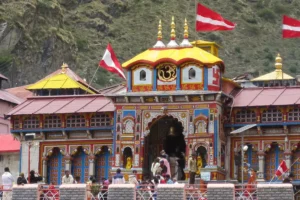Kedarnath Temple
Kedarnath Temple holds a special place among Hindu pilgrims devoted to Lord Shiva. Counted among the twelve sacred Jyotirlingas, the shrine stands at an elevation of 3,583 meters in the Garhwal Himalayas, close to the banks of the Mandakini River.
What to Know About Kedarnath
Kedarnath is one of the holiest pilgrimage sites in India, resting high in the Garhwal Himalayas. It is one of the four sacred Char Dhams, along with Yamunotri, Gangotri, and Badrinath.The town surrounds the ancient Kedarnath temple and stands at an altitude of 3,580 meters, close to the Chorabari Glacier—the origin of the Mandakini River. Dedicated to Lord Shiva, the temple is built with large, neatly cut grey stone slabs and showcases remarkable stone architecture. Inside, a naturally formed conical rock is worshipped as Lord Shiva in his eternal form, “Sadashiva.” The shrine is not only a vital part of Char Dham pilgrimage circuit, and is one of the 12 Jyotirlingas of Lord Shiva in India. Behind the temple rise the towering Kedarnath peak, Kedar Dome, and other majestic Himalayan summits.
Historically, the region is called “Kedar Khand.” According to mythology, after the battle of Kurukshetra, the Pandavas sought Lord Shiva’s blessings to wash away their sins. The Lord avoided them and finally appeared in Kedarnath as a bull. He vanished into the earth, leaving his hump at the present temple site. Other parts of his form appeared in four different locations, which are now worshipped as his other manifestations.
Kedarnath Temple Inside
The entrance hall of the temple displays statues of Parvati, the Pandavas, Draupadi, Lord Krishna, Virbhadra (a guardian of Shiva), Nandi the bull, and other divine figures. A massive statue of Nandi faces the temple gate. Inside, the conical rock representing Lord Shiva’s Sadashiva form is enshrined in the “Garba Griha,” while a spacious Mandap is provided for devotees to gather and pray.
Kedarnath Temple Architecture
Constructed from massive grey stone blocks, the temple stands without mortar, with slabs interlocked using iron clamps. This timeless design has allowed the shrine to withstand centuries of harsh Himalayan weather.
The centerpiece is the irregular-shaped Shiva lingam, set on a cylindrical pedestal measuring about 12 feet in circumference and height. This striking feature highlights the temple’s ancient craftsmanship.
What To Do
- Kedarnath Trek: The Kedarnath trek is the most famous activity here. Stretching 16 kilometers from Gaurikund to the temple, the route passes through lush forests, streams, waterfalls, and glaciers. The trek is moderately difficult and is open between 4 a.m. and 1:30 p.m., aligning with sanctuary rules.
- Bhairavnath Temple: From the temple, pilgrims can climb another 800 meters uphill to Bhairavnath Temple, which offers panoramic views of Kedarnath town and valley. Adventurers can also trek further to Chandrashila peak, located 32 kilometers away.
- Chandrashila Peak: Adventurers can also trek further to Chandrashila peak, located 32 kilometers away.
- Camping: For those who enjoy nature, camping near Kedarnath town is a serene experience. The snow-clad peaks, starry skies, and divine atmosphere make the stay unforgettable.
- Mountaineering: Mountaineers also find challenges here—the Kedarnath peak and Kedar Dome offer climbing opportunities with rock walls, ice formations, and crevasses. The northwest sides are easier to scale, while the eastern face of Kedar Dome presents a more technical climb.
How to Reach
Kedarnath can be reached mainly by trekking, though helicopter services are also available. The last motorable point is Gaurikund, from where the 16–18 km uphill trek begins. The nearest railway station is Rishikesh, while the closest airport is Jolly Grant in Dehradun.
- By Flight: Jolly Grant Airport, located 238 km from Kedarnath, is well-connected to Delhi with regular flights. From the airport, taxis are available to Gaurikund.
- By Train: Rishikesh railway station, about 216 km before Kedarnath on NH58, is the nearest railhead. It has frequent connections to major Indian cities. From Rishikesh, buses and taxis operate to Gaurikund.
- By Road: The motorable road ends at Gaurikund, from where the trek to Kedarnath begins. Gaurikund is connected by National Highway 109 and is accessible from Haridwar, Rishikesh, Dehradun, Srinagar, Chamoli, and other towns. Buses are available from ISBT Kashmiri Gate in Delhi to Rishikesh and further towards Gaurikund.
- By Shuttle Helicopter: Helicopter services from Phata, Guptkashi, and Sersi make reaching Kedarnath more convenient for devotees.
Best Time to Visit Kedarnath
The ideal time to plan a visit is from May to October. During winter, the region remains closed due to heavy snowfall, and the idol of Lord Shiva is shifted to Ukhimath for worship.





